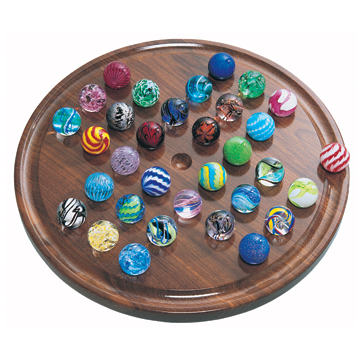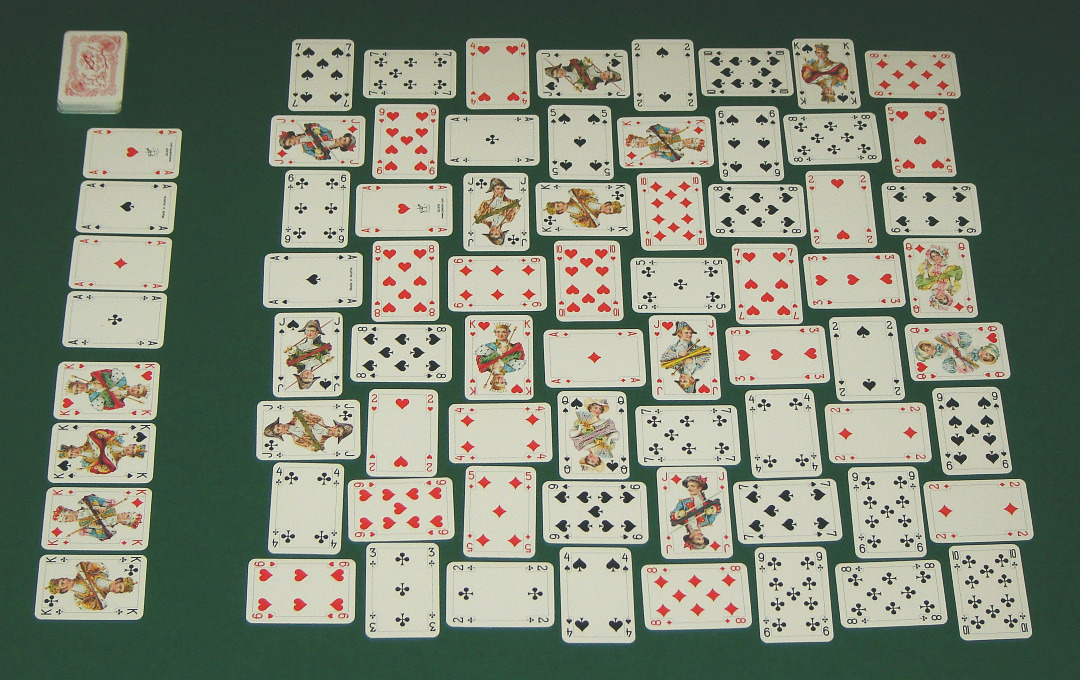|
Three Shuffles And A Draw
Three Shuffles and a Draw is a solitaire game using one deck of playing cards. This game is similar to La Belle Lucie besides being able to draw one card after the second shuffle."La Belle Lucie" (p.54) in ''The Little Book of Solitaire'', Running Press, 2002. The object of the game is to move all of the cards to the Foundations. Rules Three Shuffles and a Draw has four foundations build up in suit from Ace to King, e.g. A♣, 2♣, 3♣, 4♣... The Tableau is filled with eighteen piles containing three cards each, except for the last pile, only containing one card. These piles build down in suit, e.g. 8, 7, 6, 5... File:Three Shuffles and a Draw (solitaire) Layout.jpg, Three Shuffles and a Draw Layout Only the top card in the tableau piles can be played, and these cards can move to other tableau piles or to the foundations. Empty spaces cannot be filled by any other card. The name "Three Shuffles and a Draw" comes from the fact that there are 3 shuffles (counting the ... [...More Info...] [...Related Items...] OR: [Wikipedia] [Google] [Baidu] |
Solitaire
Solitaire is any tabletop game which one can play by oneself, usually with cards, but also with dominoes. The term "solitaire" is also used for single-player games of concentration and skill using a set layout tiles, pegs or stones. These games include peg solitaire and mahjong solitaire. The game is most often played by one person, but can incorporate others. History The origins of Card Solitaire or Patience are unclear, but the earliest records appear in the late 1700s across northern Europe and Scandinavia. The term ''Patiencespiel'' appears in ''Das neue Königliche L’Hombre-Spiel'', a German book published in 1788. Books were also reported to appear in Sweden and Russia in the early 1800s. There are additional references to Patience in French literature. In the United States, the first card solitaire book, ''Patience: A series of thirty games with cards'', was published by Ednah Cheney in 1870. The most popular card solitaire is Klondike, which was called Microsoft So ... [...More Info...] [...Related Items...] OR: [Wikipedia] [Google] [Baidu] |
La Belle Lucie
La Belle Lucie is a patience or card solitaire where the object is to build the cards into the foundations. It is considered to be representative of the "fan" family of solitaire card games, and has a pleasing layout. While the game originated in France as La Belle Lucie, it is also known under the name Lovely Lucy. Other common names and closely related variants include The Fan, Clover Leaves, Three Shuffles and a Draw, Alexander the Great, Trefoil, and Midnight Oil. All cards are visible from the start, but this does not imply that this game is solvable with strategy, because the game is very hard to win under the default rules. For example, moving a single card onto another blocks that stack until both cards can be removed to the foundations. Any setup that has a lower card of a specific suit below a higher of the same suit, or all kings not on the bottom of each cascade cannot be solved without cheating. The shuffle and redeal is of little help. For each king left in th ... [...More Info...] [...Related Items...] OR: [Wikipedia] [Google] [Baidu] |
Glossary Of Solitaire Terms
Games of patience, or (card) solitaires as they are usually called in North America, have their own 'language' of specialised terms such as "building down", "packing", "foundations", "talon" and "tableau". Once learnt they are helpful in describing, succinctly and accurately, how the games are played. Patience games are usually for a single player, although a small number have been designed for two and, in rare cases, three or even four players. They are games of skill or chance or a combination of the two. There are three classes of patience grouped by object. The most frequent object is to arrange the cards either in ascending sequence (e.g. from Ace to King) or descending sequence. Occasionally both forms of sequence are aimed at in the same game. The card forming the starting point of the required sequence is known as the foundation card and the sequence or family is said to be 'built up' on such card. In some cases foundation cards are picked out and placed in position ... [...More Info...] [...Related Items...] OR: [Wikipedia] [Google] [Baidu] |
List Of Solitaires
This is a list of patiences, which are card games that are also referred to as solitaires or as card solitaire. This list is not intended to be exhaustive, but only includes games that have met the usual Wikipedia requirements (e.g. notability). Additions should only be made if there is an existing entry on Wikipedia that they can be linked to. To avoid duplicate pages being created, alternative titles and the names of variants are listed separately (except titles that include little more than the name of the parent game). Games of the patience genre played by more than one player are marked with a plus (+) sign. A * Accordion * Aces and Kings * Aces Square * Aces Up * Acme * Addiction * Agnes * Alaska * Algerian * Alhambra * Amazons * American Toad * Apophis * Appreciate * Acquaintance * Archway * Auld Lang Syne * Australian Patience B * Babette * Backbone * Baker's Dozen * Baker's Game * Baroness * Batsford * Beetle * Beleaguered Castle * Belvedere * ... [...More Info...] [...Related Items...] OR: [Wikipedia] [Google] [Baidu] |
Glossary Of Solitaire
Games of patience, or (card) solitaires as they are usually called in North America, have their own 'language' of specialised terms such as "building down", "packing", "foundations", "talon" and "tableau". Once learnt they are helpful in describing, succinctly and accurately, how the games are played. Patience games are usually for a single player, although a small number have been designed for two and, in rare cases, three or even four players. They are games of skill or chance or a combination of the two. There are three classes of patience grouped by object. The most frequent object is to arrange the cards either in ascending sequence (e.g. from Ace to King) or descending sequence. Occasionally both forms of sequence are aimed at in the same game. The card forming the starting point of the required sequence is known as the foundation card and the sequence or family is said to be 'built up' on such card. In some cases foundation cards are picked out and placed in position ... [...More Info...] [...Related Items...] OR: [Wikipedia] [Google] [Baidu] |



